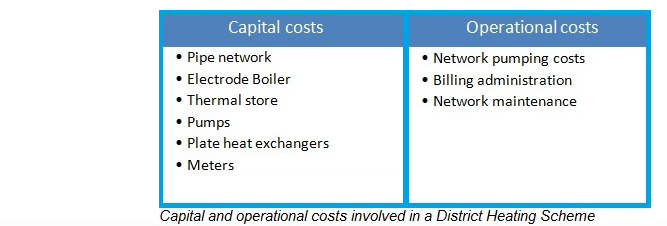
A major aspect of the project is the financial analysis and sensitivity analyse of the two district heating scenarios. For the council to make an informed decision on the viability of such a scheme it will need accurate projections for all the financial aspects of the project. This section looks at the financial analysis of two district heating scenarios investigated for the town of Kirkwall.
As previosuly mentioned, district heating networks have a low penetration in the market in the United Kingdom. The main explanation for this fact is the high capital cost assosiated with providing heat through district heating in comparison with other individual conventional gas or electric-based heating systems. Certainly, district heating schemes are long-term projects with long-term payback periods. They are unlikely to be suited to short-term investors.
FINANCIAL ANALYSIS BREAKDOWN
The two key areas of consideration in the financial analysis were the operational and the capital costs associated with both scenarios. The captial cost is the cost associated with installing the scheme, while the operational costs are related to the running and maintenance of the network. The key elements of both categories are shown in the table below.

KEY FINANCIAL ELEMENTS
The biggest capital cost associated with both district heating scenarios is the investment required to establish the pipe network. The cost to install district heating pipes along with all the additional equipment can vary significantly depending on the surface type and the structure of the surface beneath. Consequently, without a detailed survey of the ground in which the pipes will be buried it is hard to establish an exact cost. However, from out research we found that the price can vary from £500,000/km- £1,000,000/km and the group selected a price of £800,000/km for the purpose of our project.
The next considerable capital cost is that associated with the electrode boiler and the thermal store and all related equipment. The thermal store was priced according to an estimation of £1/litre of storage which was established from contact with the industry.
KEY FINANCIAL ASSUMPTIONS
As with any engineering project of this nature that is in the initial research and planning stages, there are several assumptions that may influence the accuracy of the financial projections. These key financial assumptions are detailed below.
- It was assumed that the price of heating oil will increase each year at a rate of 8%, while the price to buy the electricity will increase at a much slower rate of 1%. Consequently, the projected savings for the council will increase each year.
- The entire capital cost of the project has been included in the first year of the financial projections. Consequently, the only costs to the council after year one are the operational costs.
- The connection costs to the local heat main and that of installing the local plate heat exchangers is paid by the customer (this applies to the second scenario where 14 private residences are included), with exception of the buildings owned by the council.
- The heating demand from the buildings attached to the network will remain the same each year. In reality, it is expected that the heating demand from buildings in the near future will decrease due to the expected improvements in the energy efficency of builidings as the ideal 'passive house' is pursued.
- All capital and operational costs are based on the best information available and educated estimations.
- The total heating demand for which the financial analysis is performed includes all heat losses and inefficiencies in the boiler.
- The total revenue from the cutomers and savings from avoiding any expenditure on heating oil is based only on the percentage of the time when the district heating network can provide hot water. This has been established through the thermal store simulations detailed within the case study.
FINANCIAL RESULTS
The financial information and analysis for the two main scenarios studied in this project is detailed within the following links
- Scenario 1:Council Headquarters and Papdale Primary School
- Scenario 2: Scenario 1 plus 14 houses in White Street and new council building
- Faber Maunsell, A. (2009). The potential and cost of District Heating Networks. A report to the Department of Energy and Climate Change. Oxford: Poyry Energy Ltd.
References: